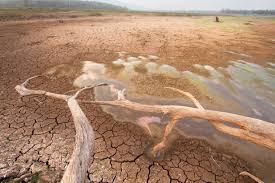
Drought is one of the most devastating natural disasters, affecting millions of people and ecosystems worldwide. It is a prolonged period of insufficient rainfall, resulting in water shortages, agricultural losses, and severe socio-economic impacts. In recent years, the frequency and intensity of droughts have increased due to climate change, posing a significant challenge for governments, communities, and industries.
Causes of Drought
Droughts are caused by a combination of natural and human factors. The primary causes include:Climate Change: Global warming is altering weather patterns, reducing precipitation in some regions while increasing evaporation rates. This results in more frequent and severe droughts.Deforestation: Large-scale deforestation disrupts the water cycle, leading to reduced rainfall and soil moisture.Unsustainable Water Use: Excessive extraction of groundwater for irrigation, industrial use, and urban consumption depletes water reserves, exacerbating drought conditions.Overgrazing and Land Degradation: Poor land management practices degrade soil quality, reducing its ability to retain moisture and increasing vulnerability to drought.
Impact of Drought
The impact of drought extends beyond water scarcity, affecting various aspects of life, particularly in agriculture-dependent regions. Key impacts include:
Agricultural Losses
Drought severely affects crop yields, leading to food shortages and increased prices. Livestock may die due to a lack of water and pasture, putting a strain on farmers and rural communities. In many cases, droughts force farmers to abandon their land, causing long-term economic damage.
Water Scarcity
A lack of rainfall reduces the availability of freshwater for drinking, sanitation, and industrial use. This scarcity often leads to rationing, conflicts over water resources, and the spread of waterborne diseases due to poor hygiene practices.
Economic Impact
Drought negatively affects economies reliant on agriculture and natural resources. It can lead to job losses, reduced income, and increased poverty in rural areas. The global economy also feels the impact through higher food prices and disrupted supply chains.
Environmental Degradation
Prolonged droughts lead to the drying up of rivers, lakes, and wetlands, causing habitat loss for aquatic species. Forests and grasslands are also vulnerable, increasing the risk of wildfires. The loss of biodiversity disrupts ecosystems and diminishes nature’s ability to provide essential services like pollination and carbon sequestration.
Humanitarian Crisis
Drought often triggers large-scale migration as people move in search of water, food, and livelihoods. It also contributes to political instability, particularly in regions already facing conflict or governance challenges. Drought-induced food shortages can lead to malnutrition, especially among children, exacerbating health crises.Case Studies of Drought-Affected Regions.
Horn of Africa
The Horn of Africa, including countries like Somalia, Kenya, and Ethiopia, has been severely impacted by recurrent droughts. In recent years, the region has experienced some of its driest conditions in decades, leading to widespread famine and displacement. Millions of people depend on humanitarian aid for survival.
California, USA
California has been facing severe drought conditions for the past few years, largely attributed to climate change. The state’s agriculture, which supplies a significant portion of the nation’s produce, has been deeply affected. Droughts have also contributed to devastating wildfires, causing extensive damage to homes, infrastructure, and ecosystems.
Australia
Australia is no stranger to drought, with many parts of the country experiencing “mega-droughts” that can last for decades. The “Millennium Drought” (1997-2009) was one of the most prolonged and devastating droughts in the country’s history, impacting water supplies, agriculture, and urban areas.Solutions to Combat Drought.
Improved Water Management
Efficient water use and management are key to reducing drought impacts. This includes investing in water-saving technologies, repairing infrastructure to reduce water loss, and adopting sustainable irrigation methods like drip irrigation.
Reforestation and Land Conservation
Reforestation and land conservation can help restore ecosystems and improve the water cycle. Planting trees increases rainfall and replenishes groundwater supplies, while sustainable land management practices prevent soil erosion and desertification.
Climate Change Mitigation
Reducing greenhouse gas emissions is crucial to slowing the pace of climate change and reducing the likelihood of severe droughts. Global efforts must focus on transitioning to renewable energy sources, improving energy efficiency, and promoting sustainable practices across industries.
Drought Early Warning Systems
Investing in early warning systems can help communities prepare for droughts before they become crises. These systems provide timely information on weather patterns, allowing governments and communities to implement water-saving measures, allocate resources, and prevent the worst impacts of drought.
Community Engagement and Resilience Building
Building resilient communities is essential for long-term drought management. This involves engaging local communities in water conservation efforts, improving access to education and resources, and strengthening social safety nets to support vulnerable populations during times of crisis.
The drought crisis is a global issue that demands urgent attention and coordinated action. Climate change, unsustainable water use, and poor land management practices are key drivers of drought, leading to widespread humanitarian, economic, and environmental impacts. To mitigate these effects, global efforts must focus on sustainable water management, ecosystem restoration, and climate change mitigation. Only through collective action can we build a more resilient world, capable of withstanding the growing threat of drought.
Subscribe to Follow Global Trends for daily global news.
Find Out How To Make Money As A Full Time Writer/Blogger Guide.
To Advertise, Advertise Your Affiliate Links on FollowGlobalTrends.com for Just $1 Per Link Per Month!
Related Articles
Written By: Enyoghasi Ngozi pricillia
,

